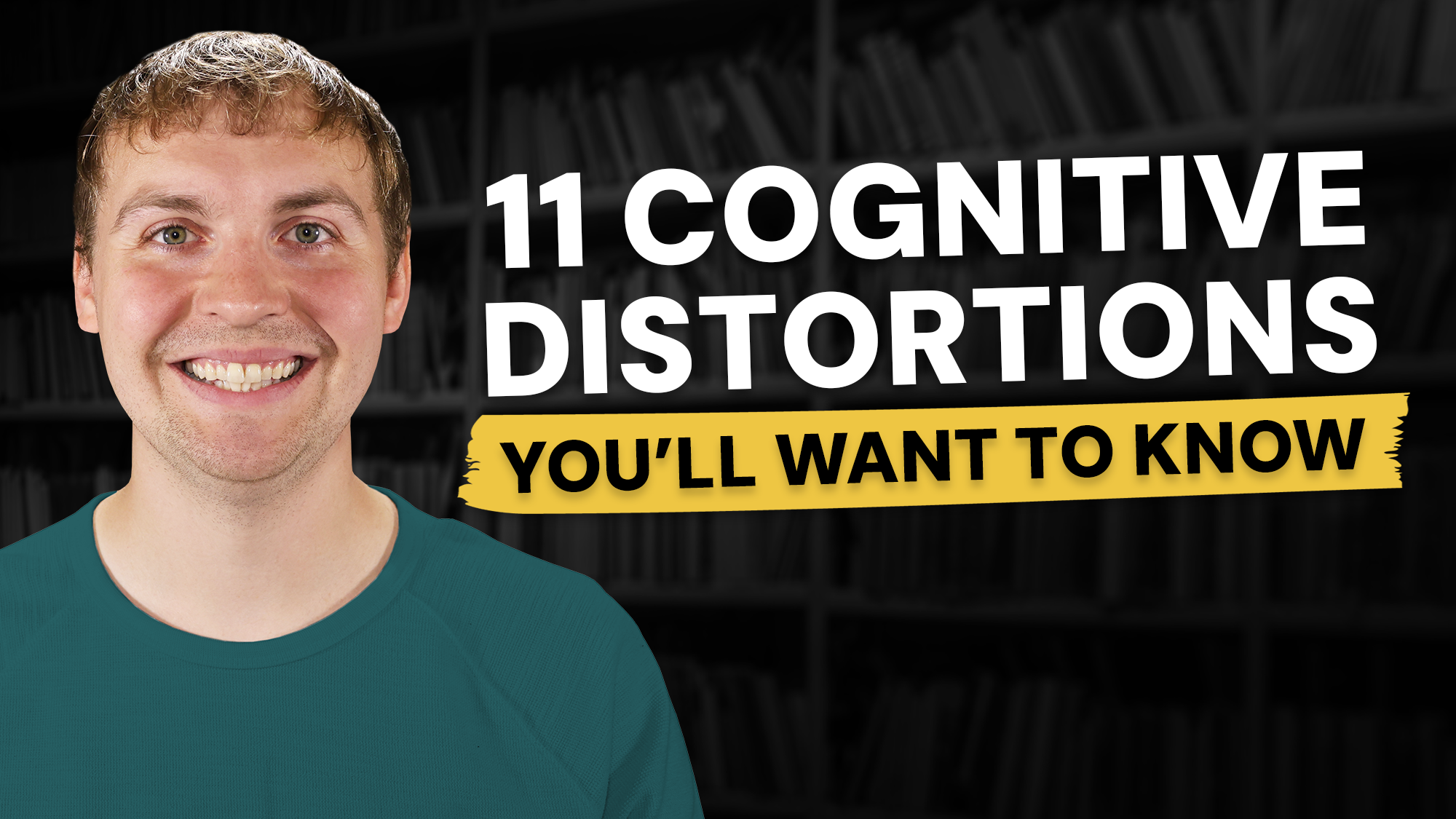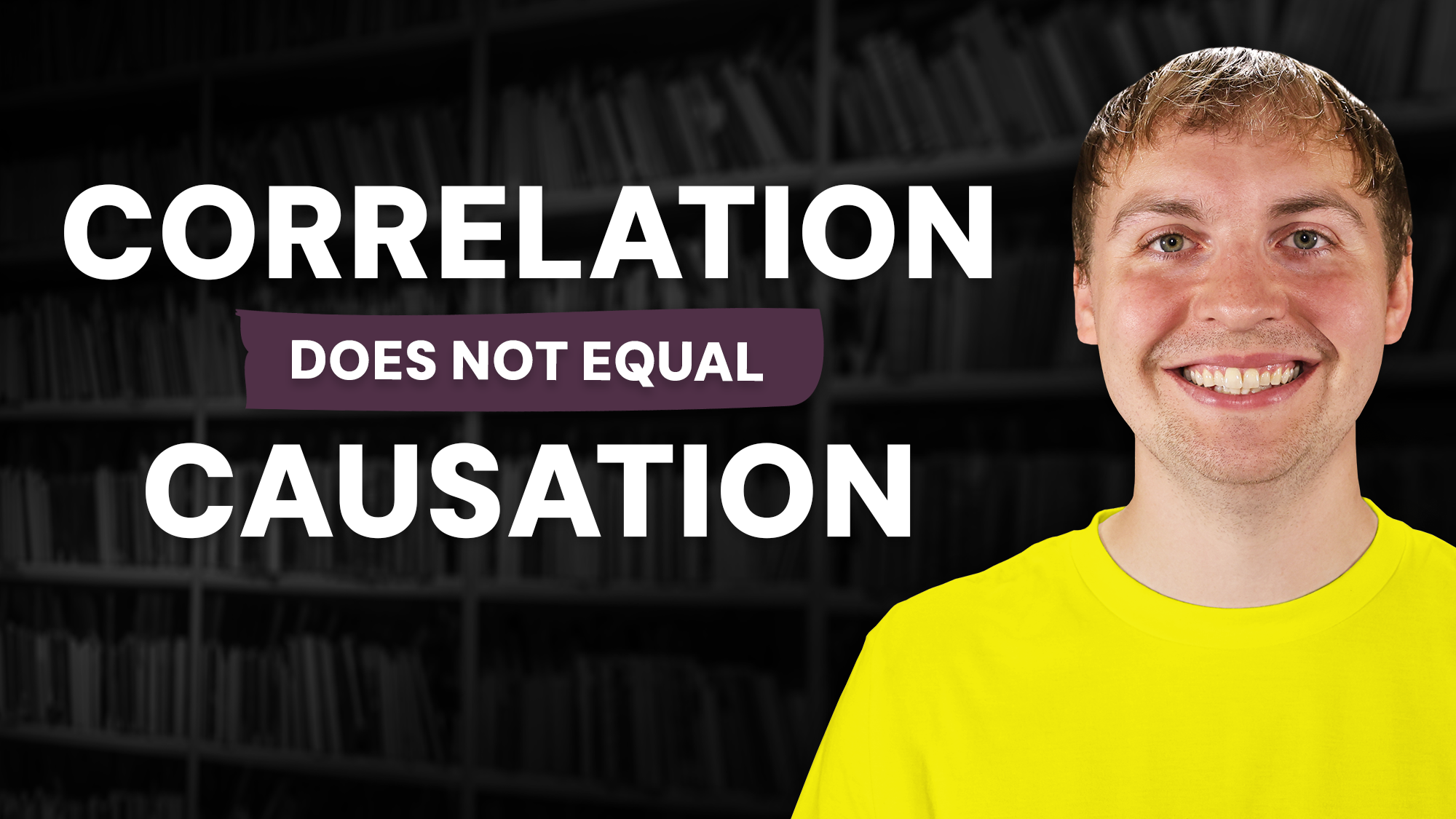
Cognitive Distortions are a topic that is discussed in psychology classes and therapy sessions alike! In this post and corresponding video, we’re covering 11 common distortions. We don’t stop there though! We also go over some tips for recognizing and challenging these distortions!
Before we discuss the Cognitive Distortions themselves, we need to define what cognitive distortions are overall.
According to the American Psychological Association, they are “faulty or inaccurate thinking, perception, or belief”. Cognitive distortions occur automatically and can be tricky for the person with the distortion to see. This is one of the ways that therapy can be helpful for people—it is a way for them to begin to more easily recognize their distortions.
For cognitive behavioral therapists, they tend to believe that there is a “real” version of the world and what is going on, but that people also separately have their own perception of this. This means that Cognitive Distortions are often a misperception or misinterpretation of the real world.
Before we go over the actual cognitive distortions, note that we are not covering all cognitive distortions here. That said, we will be talking about some of the most common distortions. It might also be helpful to recognize that the distortions can often overlap. Meaning, you might see distortions here that are very similar, or that have aspects of other distortions that we discuss.
All-or-Nothing Thinking
First, all-or0nothing thinking. This one can go by a couple of other names as well, so you might also hear this called black-and-white thinking or dichotomous thinking. With this distortion, a person will view a situation as only having two outcomes that exist. An example of all or nothing thinking might be if someone gets one answer wrong on a test and says they’re a failure. The all-or-nothing thinking here is that their view is that they have to do perfect otherwise they are a failure.
Catastrophization
Second is catastrophization. When a person is catastrophizing, they are predicting future bad things to happen and not considering or ignoring possible positive or neutral outcomes. For example, if a person sends an email to their boss and notices that they had a typo in the email after they sent it, then thinks that their boss is going to think they’re so stupid, and that their boss might wonder if they’re actually a good employee, and so on—this person is then catastrophizing. They are not considering that everyone makes typos, that their boss may notice and think nothing of it, or that their boss may not even notice they had the mistake in the email.
Fortune Telling
Fortune telling is third. A quick note, some people consider catastrophizing and fortune telling to be the same distortion. However, some consider fortune telling to be a distortion of its own. For those that see it as a separate cognitive distortion, they differentiate it as the person predicting future events or outcomes with little evidence of the outcome. An example of fortune telling might be if a person called a friend and the friend hadn’t returned the call within an hour, so the person starts to worry that the friend may have died in an accident. Someone not returning a call within an hour isn’t evidence for a person being in an accident on its own. We would need more information to determine if the friend was in an accident. Therefore, the person’s mind jumping to this demonstrates the fortune telling distortion.
Mind Reading
Fourth, mind reading. As the name suggests, the mind reading distortion is where a person believes they know what other people are thinking without having any evidence that this is what they’re thinking. For example, if someone sees another person whisper into someone’s ear, then they start to think that these people must be talking about them, and that these people must not like them, this would be an example of the mind reading distortion. They have no evidence that these people are whispering about them, but this is where their mind went automatically.
Disqualifying/Discounting the Positive
The fifth distortion is disqualifying or discounting the positive. With this distortion, the person does not pay attention to, or give the appropriate weight to positive information. They don’t count the positive things in a situation. An example of this might be if a person gets a compliment on a new shirt they’re wearing, then starts to think that the compliment was just because the person noticed it was new. They didn’t compliment the shirt because they actually thought it was nice. But not actually accepting the compliment and going to the negative, we can see the discounting the positive distortion.
Magnification/Minimization
Next are magnification and minimization. This is similar, yet different, from some of the others we’ve discussed. With this distortion, the person magnifies the negative and minimizes the positive. In other words, they put extra focus on the negative and also put less focus on the positives in a situation. Imagine someone had guests over and made pasta. The guest complimented the pasta, but the person who cooked it responded that it was nothing, it was just a quick and simple recipe. We see the magnification and minimization distortion in the cook’s response. By saying it was a simple and easy recipe, they’re magnifying something they perceive as bad. They also ignore the compliment, thereby minimizing the positive.
Selective Abstraction
Seventh is selective abstraction, or sometimes called the mental filter distortion. With this distortion, rather than looking at the big picture and all the various parts of a situation, the person will focus in and only pay attention to a negative detail. An example of selective abstraction might be if a person completes a semester of a class with an overall grade of an A, but they received a grade of a B on one assignment and only focus on that grade and feel that they should have done better. Therefore, the distortion is only focusing on the B, not considering the overall grade in the class or how they received high grades on all the other assignments.
Overgeneralization
Overgeneralization is the eighth distortion. With this distortion, the person makes broad and sweeping statements or conclusions that go beyond the information available. For example, let’s say that a person was dating a person who works as a bartender and the bartender says they’re not interested in going on additional dates. If the person has never dated another bartender, but then says they’re never dating another bartender as they’re the worst and it never works to date bartenders, this would be an overgeneralization. They have no other experience with dating bartenders to pull from, yet are saying they’re terrible and don’t want to date other bartenders, meaning they’re overgeneralizing that one experience to other bartenders.
Misattribution
The ninth distortion is misattribution. This distortion is where a person puts the blame for something on the wrong thing, and doesn’t give other explanations enough consideration. Let’s look at an example to help this make more sense. Imagine a person was assigned to give a presentation at work with a coworker they don’t know well and don’t usually have contact with. On the day of the presentation, their co-worker ends up being 15 minutes late for their presentation. Then the person jumps to the conclusion that the coworker wanted the presentation to fail and they’re just so lazy and selfish this was bound to happen. This is misattribution as we don’t have any reason to believe the co-worker wanted the presentation to fail, nor do we have evidence they’re selfish and lazy. Instead, it may have been that they got a flat tire or that their child was sick. In other words, there are other possible reasons they may have been late.
Personalization
Personalization is the tenth distortion. Similarly, personalization is a distortion where the person believes other people are behaving in a negative way because of them. For example, let’s say a person gets called into their boss’s office. The boss seems frustrated and on edge, and tells the person about a project they need to start working on as the highest priority to get things fixed. The person might think they did something wrong and that’s why they’re having to fix it, and that this is also what explains the boss’s irritable tone. However, they’re not considering other explanations. It may have been that the boss trusted them and their work and that’s why they’re getting assigned to work on this project, and that maybe another employee had messed something up instead.
Emotional Reasoning
Next, the final distortion is called emotional reasoning. This distortion is where a person believes that something is a specific way because they feel that it is this way. Such as thinking something is true because they feel it is true, or believing something is bad because they feel that it is bad. An example of this might be if a person is feeling nervous about an upcoming presentation, and then believes they’re going to do terrible on this because they’re nervous. This is the emotional reasoning distortion as feeling nervous about a presentation is quite normal, and being nervous for something doesn’t mean we’re going to fail at it.
Now that we’ve discussed some common cognitive distortions, let’s take a look at some ways to start to recognize them. The APA says that “cognitive distortion is a normal psychological process that can occur in all people to a greater or lesser extent.” So, whether these are tips you want to try for yourself, or something you’re working on with a client, hopefully they’ll be helpful. I often say, if we don’t know something is a problem, we can’t address that. Therefore, recognizing and identifying cognitive distortions is a very important first step.
Tip 1 – Journaling
The first tip would be journaling. This is a helpful way for us to start to recognize and break down our own thoughts and to work with our thoughts in a different way. By journaling about different situations throughout our day or week, we might be able to start recognizing some of the distortions that could be at play. Also, keep in mind that distortions will overlap and that there can also be more than one distortion happening at a time!
Tip 2 – Examining the Evidence
Second, examine the evidence. This is something you could do as part of a journaling exercise or just doing mentally. Either way, find a situation that has been a source of frustration, annoyance, or some other negative situation. Then, write down or pay attention to the different thoughts you have, especially the more negative ones. Once you have figured out some of the negative thoughts and reactions, start to look for evidence to support these, but also look for the evidence that would go against your reactions.
Tip 3 – Notice Your Words
A third tip is to pay attention to the words you’re using. If you catch yourself using words like always, never, should, or must, these are often a red flag that there is a cognitive distortion happening. It’s pretty uncommon for something to always be the case or to never happen. Likewise, if you feel that you must or should do something, it may be helpful to explore where this belief may come from.
Tip 4 – Call it Out!
As a final tip, when you notice a cognitive distortion, call it out! You don’t have to do this out loud, but try to label this distortion in your might. This can be something as simple as, “I am noticing myself catastrophizing as I am feeling that I have to quadruple check for any minor typos so that people don’t judge me”. If you can, you might even try to bring more balance as the distortion is happening by adding something like, “everyone makes typos. I’ve already checked this and I’m sure it is just fine. Even if there is a typo, it isn’t a big deal”.



If you or someone you know are needing immediate mental health assistance, please call or text 988, contact a local emergency telephone number, or go to the nearest emergency room.
By interacting with this website and channel, this does not constitute a therapist/client relationship. This content is intended for the purposes of entertainment and mental health education.
View additional disclaimers and notices on our Disclaimers page.